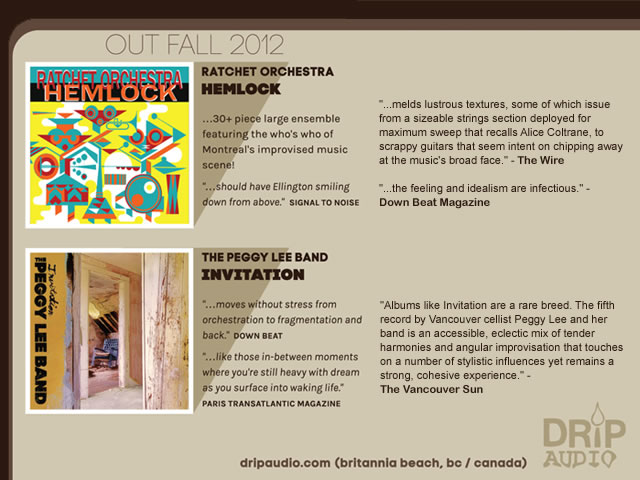Moment's Notice
Reviews of Recent Recordings
(continued)
Paul Giallorenzo’s Gitgo
Emergent
Leo 641
Marc Riordan Quartet
Binoculars
Club Nerodia 01
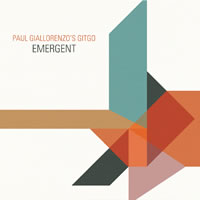
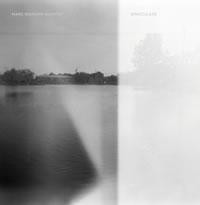 Again, new music from Chicago’s fiery new-jazz stew. Again, vivid concepts of composing and improvisational structure are central to the musics, and again, the albums are very different from each other. Gitgo is a quintet and Paul Giallorenzo is a straightahead, no-BS pianist who invents flowing lines with a minimum of decoration or digression. His touch is Listen, you! strong, his solos and aggressive duets are gems of after-bop, after-Bley melody. The straightahead, no-BS propulsion of Anton Hatwich and Marc Riordan match Giallorenzo’s energy – Hatwich plays bass with a big sound and Riordan is an active yet smart drummer. Trombonist Jeb Bishop and saxist Mars Williams create sparks together. Here Bishop is busier than ancestors like Roswell Rudd and Steve Swell, while Williams plays some of the best tenor and soprano music I’ve yet heard from him on recordings.
Again, new music from Chicago’s fiery new-jazz stew. Again, vivid concepts of composing and improvisational structure are central to the musics, and again, the albums are very different from each other. Gitgo is a quintet and Paul Giallorenzo is a straightahead, no-BS pianist who invents flowing lines with a minimum of decoration or digression. His touch is Listen, you! strong, his solos and aggressive duets are gems of after-bop, after-Bley melody. The straightahead, no-BS propulsion of Anton Hatwich and Marc Riordan match Giallorenzo’s energy – Hatwich plays bass with a big sound and Riordan is an active yet smart drummer. Trombonist Jeb Bishop and saxist Mars Williams create sparks together. Here Bishop is busier than ancestors like Roswell Rudd and Steve Swell, while Williams plays some of the best tenor and soprano music I’ve yet heard from him on recordings.
Giallorenzo’s songs and settings – most tempos are brisk, for one thing – make for a bright band sound. I love the theme, swing, and energy of “Spring Chicken”; the free swing of the trombone solo, then the sudden, vicious soprano assault in “Want It”; the way the five bat about the stair-step theme of “Slowed Roll,” in which the piano left hand stalks the trombone in duet. “Imprograf” starts with a long, grand, near-Verdi theme. While Williams’ tenor solo is fierce, screaming, the net effect is somehow stately next to the fine, unaccompanied, fast trombone-piano duet that follows; soon it morphs into a quintet improvisation. “Spatialist (for Fred Anderson)” has a long dirge theme with tenor and wa-wa-muted trombone in harmony. The sorrowing trombone solo that follows includes tenor and piano commentary that gradually grow it into a speeding group improvisation. Williams used to be a Roscoe Mitchell student, and he never sounded more Roscoe-like than he does on soprano here, with fantastic angles and tangles growing out of knotted phrases. Enjoyable as the parts are, it’s the way Giallorenzo makes them fit and sum up that makes Emergent special.
Riordan, best known by far as a fine drummer, only plays piano in Binoculars, and his piano ideas prove to be intriguing and highly eclectic. The album starts out casting in several outside directions, including an Ornettish theme “Funometer,” before discovering 21st-century successors to Thelonious Monkish grooves. Almost half of the CD is duets with altoist Peter Hanson – Lyons-Taylor duets, Marsh-Tristano duets, Rouse-Monk duets (though the sound is more like Gryce-Monk). Monk is his most frequent inspiration – bless Riordan for having the heart and skill to base his own music on near-Monk. In fact, “Lesson Learned” is “Monk’s Mood” cleverly cubed and reassembled, though the tempo is medium and Riordan in solo is too innately bright-tempered to reflect the master’s melancholy. His “On the 6th” solo is built on the angular theme, with spacey phrase dislocations and bluesy harmonies built from seconds, though unlike Monk, Riordan’s form is dispersed and he plays resolutions on downbeats. Attention, Monk completists! The one non-original piece here is Monk’s lovely yet seldom-heard “A Merrier Christmas,” sweetly played.
Hanson is a rough player, eclectic, mainly a crude Jimmy Lyons who offers good solos in “On the 6th” and “I’ll Text You” – boppish, that one – and more troubled playing in four duets. Against the flowing piano lines Hanson’s sax lines often sound broken, disorderly, though the duets include intriguing passages in which piano and sax echo or take off from each other – then, Hanson sounds together, an equal partner. In the title piece, which has a strange meter, the two play independent, simultaneous solos, leading to Tim Daisy’s clever, rim-rattling drum solo. While Daisy is good, bassist Daniel Thatcher sometimes sounds muzzy to me; I like his “I’ll Text You” solo. Altogether, Binoculars is another reason why now is sure a fine time to be a music lover in Chicago.
–John Litweiler
Grass Roots
Grass Roots
AUM Fidelity AUM075
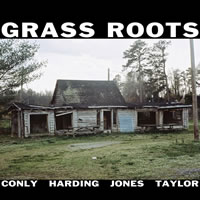 According to Merriam-Webster’s English Dictionary, the primary definition of grass roots is “the very foundation or source.” Rarely however, has “the very foundation or source” of an art form been as raw as the torrid expressionism featured on the self-titled AUM Fidelity debut of the cooperative American quartet Grass Roots. Hailing from various locations across the country, the muscular front line is comprised of Richmond, Virginia-born alto saxophone phenomenon Darius Jones and Detroit native Alex Harding on baritone saxophone, with the elastic rhythm section consisting of bassist Sean Conly, originally from Kansas City, and Chicago-raised drummer Chad Taylor.
According to Merriam-Webster’s English Dictionary, the primary definition of grass roots is “the very foundation or source.” Rarely however, has “the very foundation or source” of an art form been as raw as the torrid expressionism featured on the self-titled AUM Fidelity debut of the cooperative American quartet Grass Roots. Hailing from various locations across the country, the muscular front line is comprised of Richmond, Virginia-born alto saxophone phenomenon Darius Jones and Detroit native Alex Harding on baritone saxophone, with the elastic rhythm section consisting of bassist Sean Conly, originally from Kansas City, and Chicago-raised drummer Chad Taylor.
As the most visibly celebrated member, Jones hardly needs an introduction; his four previous AUM Fidelity releases have deservedly garnered widespread critical acclaim. His singular approach to the alto exudes a deep, soulful authenticity that hearkens back to the rugged individualism of a previous era. Although Jones’ star is on the rise, Harding’s stalwart reputation has been well documented as a sideman in the bands of Ahmed Abdullah, Hamiet Bluiett and Elliott Sharp, as well as a bandleader of his own accord. Inspired in part by Jones’ unfettered zeal, Harding holds his own in the upstart’s company, matching each of Jones’ trenchant cries, guttural slurs and multiphonic bellows with his own equally ecstatic variations. Taylor’s work with Rob Mazurek in various editions of the Chicago Underground collective and an assortment of non-jazz related artists – such as Iron and Wine and Sam Prekop – instills his attentive trap set permutations with an omnifarious sensibility comparable to Conly’s malleable bass technique. In addition to performing in Jones’ regular quartet, Conly’s diverse resume boasts sideman gigs with an array of musicians, including Regina Carter, Paquito De Rivera and Greg Tardy. Together these four sublimate ego for mutual ideology; each contributes to the writing process, with obvious consideration paid towards maintaining a unified group sound.
Even at their most outward bound, as on the manic collective improvisation, “Ricochet,” they manage to maintain a sense of focused identity. Their predilection for New Thing-era aesthetics manifests immediately on the spirited opener, “Hotttness,” which alternates between episodes of Ayler-esque frenzy and Arkestra inspired groove – a creative arc that similarly underscores tunes like “Lovelorn” and “Schnibbett.” The latter number demonstrates the group’s effortless mastery over modulating tempos and sudden shifts in texture and tone, segueing gracefully from coiled angularity and hushed pointillism to affecting catharsis. Whether careening with virtuosic precision on the old fashioned swinger “Flight AZ” or regaling with phantasmagoric detail on the impressionistic tone poem “Hovering Above,” Grass Roots conveys the egalitarian nature behind its name with infectious enthusiasm.
–Troy Collins
Mary Halvorson + Weasel Walter + Peter Evans
Mechanical Malfunction
Thirsty Ear THI 57204.2
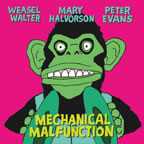 I know what you’re thinking: just how ear-bleeding a slugfest is this? Three of the most sheerly forceful young improvisers in NYC, with a shared love of noise, mischief, and occasionally technical excess? How can their follow-up to Electric Fruit be anything but ears-pinned-back hellacious? Well, dig your ears into the deceptively titled “Baring Teeth” for a gloriously spare, choppy, restrained improvisation that announces the trio’s range and depth from the outset. For this release, the trio still relies on their instrumental range and their exuberance; and they also remain, as anyone reading this surely knows, savvy enough improvisers to rely on their careful listening and rapid responsiveness. But for this release, they also explore the use of fairly structured material, mostly in the form of rhythmic cues (though there are several unison lines audible here and there). For those wanting full force, don’t worry: it’s here. Check out the stuttering staccato on “Vektor,” with Halvorson stomping pedals in time with Walter as Evans smears giant shapes (it’s almost like a No Wave band covering Braxton). But while it’s hard to deny the infectiousness of that stuff, I appreciated even more the nicely abstracted tunes like “Broken Toy,” with sweet tremolo chords and skittering cymbals, changing things up again before Evans entered to romp away like a sugar-crazed child. The mood shifts somewhat on the bitty, almost ceremonial “Klockwork” and “Freezing,” before the shuffling, staggering polyrhythms of “Malfunction” sound as if they want to race ahead of themselves before stumbling back. This rhythmic pacing, synching and departing, is a core feature of these tunes. And as a result they’re often bracingly flinty and metallic, like an improv robot huffing to life and stumbling forward via vast intervals. But as fun and excitable as the music often is, the reliance on pulse tracks wears just a bit thin over the hour (and even in those places, “Interface” for example, where Evans reaches deep into his bag of tricks and Halvorson extends across her full range it can still be a scotch wearying). That said, though, when it works it works fabulously; and this trio is also smarty enough to dial up the drowsy lyricism of “The Last Monkey on Earth” and the abstracted closer “Bulging Eyes.”
I know what you’re thinking: just how ear-bleeding a slugfest is this? Three of the most sheerly forceful young improvisers in NYC, with a shared love of noise, mischief, and occasionally technical excess? How can their follow-up to Electric Fruit be anything but ears-pinned-back hellacious? Well, dig your ears into the deceptively titled “Baring Teeth” for a gloriously spare, choppy, restrained improvisation that announces the trio’s range and depth from the outset. For this release, the trio still relies on their instrumental range and their exuberance; and they also remain, as anyone reading this surely knows, savvy enough improvisers to rely on their careful listening and rapid responsiveness. But for this release, they also explore the use of fairly structured material, mostly in the form of rhythmic cues (though there are several unison lines audible here and there). For those wanting full force, don’t worry: it’s here. Check out the stuttering staccato on “Vektor,” with Halvorson stomping pedals in time with Walter as Evans smears giant shapes (it’s almost like a No Wave band covering Braxton). But while it’s hard to deny the infectiousness of that stuff, I appreciated even more the nicely abstracted tunes like “Broken Toy,” with sweet tremolo chords and skittering cymbals, changing things up again before Evans entered to romp away like a sugar-crazed child. The mood shifts somewhat on the bitty, almost ceremonial “Klockwork” and “Freezing,” before the shuffling, staggering polyrhythms of “Malfunction” sound as if they want to race ahead of themselves before stumbling back. This rhythmic pacing, synching and departing, is a core feature of these tunes. And as a result they’re often bracingly flinty and metallic, like an improv robot huffing to life and stumbling forward via vast intervals. But as fun and excitable as the music often is, the reliance on pulse tracks wears just a bit thin over the hour (and even in those places, “Interface” for example, where Evans reaches deep into his bag of tricks and Halvorson extends across her full range it can still be a scotch wearying). That said, though, when it works it works fabulously; and this trio is also smarty enough to dial up the drowsy lyricism of “The Last Monkey on Earth” and the abstracted closer “Bulging Eyes.”
–Jason Bivins
Ben Holmes Quartet
Anvil of the Lord
Skirl 020
 First reaction: Is Ben Holmes the reincarnation of Bix Beiderbecke? There’s plenty of evidence on this CD: his warm trumpet tone, his bell-like attack, his concentration in middle registers, his rhythmic precision, his unhurried phrasing, his always strong and shapely solo designs. Most Bix-like of all, Holmes invents generous melodies – his lyricism is unwavering.
First reaction: Is Ben Holmes the reincarnation of Bix Beiderbecke? There’s plenty of evidence on this CD: his warm trumpet tone, his bell-like attack, his concentration in middle registers, his rhythmic precision, his unhurried phrasing, his always strong and shapely solo designs. Most Bix-like of all, Holmes invents generous melodies – his lyricism is unwavering.
Okay, he’s not quite the new Bix (who only played cornet and was a few decades early for free jazz quartet interplay). Holmes’s solo in “Otesanek” has lots of notes (un-Bixish), even double-time phrases, and a sorta bravura climax (un-Bixish), and he plays rare, brief double-time phrases in some other solos too. Distinctively, Holmes likes to conceive in very long phrases. His muted solo in “Kingston” is an especially fine example because his opening phrase is so lovely and he follows it with clever, equally long variations. The rest of that solo then evolves organically, a sweet creation so subtle and masterful that it makes me think of Lester Young. And Holmes constructs other solos equally subtly, skillfully. There is his arch structure in “Doodles for Rhapsody” and, in “Nada vs. Armitage,” light, simple, dancing phrases that open out and grow into long lines. The songs he composes have an exotic tint, vaguely Middle Eastern or Oriental. “Otesanek” sounds like Juan Tizol and Charles Mingus gave him some help.
The other horn here is trombonist Curtis Hasselbring, whose sound suggests both a low flugelhorn combined with a bass trumpet (a bass flugelhorn?) and whose clean articulation suggests he’s playing a valve horn. His phrasing is post-J.J. Johnson and though he’s less inspired melodically than Holmes, his formal instincts are usually similar. Their styles fit well together, they like to improvise duets in four tracks, and there’s a very good chase between the two in the title track.
The way bassist Matt Pavolka and drummer Vinnie Sperrazza kick them along in that chase is an especially good example of the way these guys play together. This is a real quartet, not just four musicians in the same room. Pavolka is strong, forceful, and invents clever solo passages. Sperrazza’s combination of discretion, sensitivity – those two words aren’t quite redundant – dynamic ingenuity, and power is unusual. So much of the quartet’s bright energy seems inspired by these two. Fascinating music.
–John Litweiler
